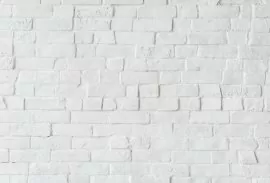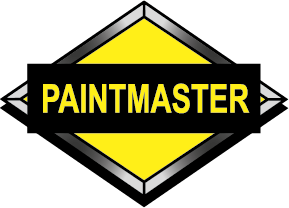
Painting masonry is a great way to protect the surface from wear and tear, as well as making it look new. As an exterior treatment, masonry paint is designed to be resistant to all kinds of damage. While this is great when it comes providing a long-term service, it can cause issues when attempting to remove it. This resilient paint can be even more difficult to remove when applied to bricks. Attempting to remove specially-designed paint from bricks and other surfaces can be incredibly difficult, and it is unlikely that simple soap and water will do the trick. How to remove masonry paint from bricks?
Whether you want to restore your bricks to their former natural colour, or you need a blank slate to change the colour of your wall, we’re here to help. The Paintmaster team has created a guide on removing damage-resistant masonry paints from all kinds of brick surfaces. Removing this treatment from your masonry walls will require aggressive cleaning products which, if used incorrectly, can be fairly dangerous.
Why Use Masonry Paint?
It may be a tricky paint to remove, but the positives outweigh the negatives. Using regular exterior paint on masonry and bricks doesn’t offer the finish or protection you need.
Even masonry surfaces that aren’t directly exposed to the elements, such as patio slabs that are sheltered, go through a lot. Masonry paint bonds to the surface, and if paired with the right primer, creates a solid layer of protection against dampness, mould, and general wear.
If you don’t use masonry paint first time, you’ll have to add new layers of inferior paint every year, costing time and money.
Why is Masonry Paint So Difficult to Remove from Bricks?
Bricks are naturally porous. That means any masonry paint or treatments applied to them will soak into the construction material itself. As soon as the paint is soaked into the masonry, it can be extremely difficult to remove.
It can be difficult enough to removal normal acrylic paint from these surfaces. However, paint designed for masonry is more resistant to any kind of damage and that means it is more resistant to being cleaned as well. Removing masonry paint from brick relies on aggressive cleaning products which, if used without due care and attention, can be extremely serious.
Should I Remove Masonry Paint?
If masonry paint is so hard to remove once dry, why remove it at all? Well, like many exterior paints and treatments, when it’s time to repaint a masonry surface, you need to remove the previous layer first.
Masonry paint is designed to cling to the stone surface; it won’t stick to old layers of paint and primer. You not only need to remove the previous layers but also clean the surface as thoroughly as possible before you start painting again. Don’t worry, we’re here to explain how to get it right first time.
Why is Masonry Paint So Difficult to Remove from Bricks?
Masonry paint can be even more difficult to remove when applied to bricks. Attempting to remove specially designed paint from bricks and other surfaces can be incredibly difficult, and it is unlikely that simple soap and water will do the trick.
Bricks are naturally porous. That means any masonry paint or treatments applied to them will soak into the construction material itself. As soon as the paint is soaked into the masonry, it can be extremely difficult to remove.
Whether you want to restore your bricks to their former natural colour, or you need a blank slate to change the colour of your wall, we’re here to help. The Paintmaster team has created a guide on removing damage-resistant masonry paints from all kinds of brick surfaces.
It can be difficult enough to removal normal acrylic paint from these surfaces. However, paint designed for masonry is more resistant to any kind of damage and that means it is more resistant to being cleaned as well. Removing masonry paint from brick relies on aggressive cleaning products which, if used without due care and attention, can be extremely serious.
How Can I Remove Masonry Paint from Bricks?
What Will I Need to Remove Paints for Masonry?
If you want to remove masonry paint from your brick’s surfaces, you’re going to need access to heavy-duty cleaning solutions.
The materials and tools that you’ll need to effectively remove this masonry paint include:
- Heavy-Duty Paint Stripper.
- Laminated Paper Paint Removal Strips.
- Protective Gear.
- Drop Cloths and Plastic Sheeting.
- Painter’s Tape.
- A Trowel, or a Drywall Knife.
- Stiff-Bristled Brush.
IMPORTANT: Paint stripper can be harmful if it touches your skin. As such, you should always take care to wear protective gear. Overalls, chemical-resistant clothing, and face protection are all essential if you want to safely apply any kind of stripping agent.
STEP ONE – Prepare the Space
Removing paint from your walls can be extremely messy. You’ll be able to reduce the amount of mess created by the paint removal by setting out your workspace in a thoughtful way. By placing multiple drop cloths, or thick plastic sheeting, on the floor you’ll be able to catch flakes of paint as it falls away from the brickwork.
For the best results, make sure to tape the cloth or sheeting to the bottom edge of the brick. If there are any areas you don’t want to catch with paint stripper, such as window frames or wood trims, make sure to cover them with painter’s tape. Once you’ve prepared your space, you’ll be able to remove the paint without causing any cosmetic damage to other areas of your property.
STEP TWO – Test your Paint Stripper
To test the effectiveness of your paint stripper, you should first use a small amount of the stripping agent on an inconspicuous part of the wall. Some masonry paints are more resistant to certain stripping agents, and some surfaces are naturally resistant to these cleaning solutions.
If you weren’t the one who initially painted the wall, sometimes the paint can be used to hide nasty surprises. For example, if the bricks have suffered any kind of damage in the past, masonry paint may have been used to cover the damage. Understanding the quality of the brick wall beneath the paint may influence your plans to remove the masonry paint or change the kind of treatment you are going to use.
Another reason you might choose to test before the stripper before beginning the project is that it can help you to understand how much effort the entire project will take. If it takes you a long time to clear a small space on your wall, you might prefer to hire a professional. Sometimes removing masonry paint yourself is more trouble than it’s worth.
But if your paint stripper is working well, move on to the next step.
STEP 3 – Apply the Paint Stripper
Before you begin to apply the stripping agent, you should scrape away any masonry paint that is already loose.
Using your trowel, or a specialised tool if you have one, apply the stripping compound to the brick surface. You need to make sure that the agent is pushes into all the crevices and gaps within the brick and mortar.
Most stripping agents will require multiple layers to be built up. Each agent has a thickness which is recommended by the manufacturer. Continue to build up and apply the substance to the wall until you reach the required thickness.
STEP FOUR – Apply the Peeling Strips
Paint peeling strips need to be attached securely to the stripping agent.
Press these strips until they are firmly attached to the masonry surface. You should make sure that these strips overlap until no brick remains visible.
Once the strips have been applied, you need to make sure that they are left for the amount of time dictated by the manufacturer. This can be anywhere from a few minutes to a couple of hours. In some cases, it can take up to 24 hours for the compound to begin working.
STEP FIVE – Remove the Peeling Strips
Once the recommended amount of time has passed, remove the paint strips.
They should peel away easily thanks to the stripping agent, removing the layer of paint in the process.
It is common for some flakes of paint to remain adhered to the wall. Using your trowel, scrape these flakes away, in addition to any stripping agent or residue left in place. If your trowel doesn’t work, scrub with a stiff-bristled brush to get the job done.
STEP SIX – Admire your Work
Once the final flakes have been removed, take a step back and admire your masonry. If the stripping agent did its job, you now have a blank canvas for a new layer of masonry paint.
For Industry-Leading Masonry Paint, Call Paintmaster Today
Here at Paintmaster, we provide a wide range of masonry paints.
If you’ve recently removed masonry paint from your brick walls and you need hard-wearing, practical replacements, take a look at what we have available.
We can deliver a full range of masonry paints and treatments to suit your needs. For more information on our wide range of acrylic masonry paint, get in touch with our experienced team today. You can reach our painting specialists directly by calling us on 01663 733633. You can also email any questions or concerns that you might have to sales@paintmaster.co.uk and we’ll get back to you as soon as we can.
If you want to learn more about both interior and exterior painting projects, check out our blog for advice and in-depth guides that suit both beginners and professional painters.
